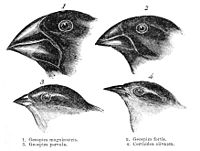
Photo from wikipedia
In genomic selection (GS), genome-wide SNP markers are used to generate genomic estimated breeding values for selection candidates. The application of GS in shellfish looks promising and has the potential… Click to show full abstract
In genomic selection (GS), genome-wide SNP markers are used to generate genomic estimated breeding values for selection candidates. The application of GS in shellfish looks promising and has the potential to help in dealing with one of the main issues currently affecting Pacific oyster production worldwide, which is the 'summer mortality syndrome'. This causes periodic mass mortality in farms worldwide and has mainly been attributed to a specific variant of the ostreid herpesvirus (OsHV-1). In the current study, we evaluated the potential of genomic selection for host resistance to OsHV-1 in Pacific oysters, and compared it with pedigree-based approaches. An OsHV-1 disease challenge was performed using an immersion-based virus exposure treatment for oysters for 7 days. A total of 768 samples were genotyped using the medium-density SNP array for oysters. A GWAS was performed for the survival trait using a GBLUP approach in blupf90 software. Heritability ranged from 0.25 ± 0.05 to 0.37 ± 0.05 (mean ± SE) based on pedigree and genomic information respectively. Genomic prediction was more accurate than pedigree prediction, and SNP density reduction had little impact on prediction accuracy until marker densities dropped below approximately 500 SNPs. This demonstrates the potential for GS in Pacific oyster breeding programmes, and importantly, demonstrates that a low number of SNPs might suffice to obtain accurate genomic estimated breeding values, thus potentially making the implementation of GS more cost effective.
Journal Title: Animal genetics
Year Published: 2020
Link to full text (if available)
Share on Social Media: Sign Up to like & get
recommendations!